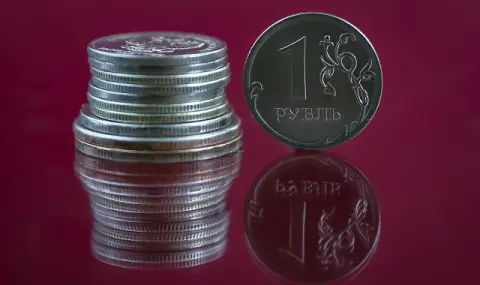New sanctions against Russia led to further devaluation of the ruble. The Russian economy is also struggling with the consequences of the war, which is absorbing colossal sums, writes ARD.
Even before Russia attacked Ukraine in February 2022, the Russian economy was not an example of smart and sustainable development. But it enjoyed stability - because of the export of raw materials. Before the start of the war, the dollar was worth 78 rubles, and now it is exchanged for 106. As the devaluation of the national currency is just one of the many signs that the country is suffering from its own aggression, writes ARD.
New sanctions imposed by the United States are believed to be the cause of the ruble's collapse. The last major Russian bank - Gazprombank - is no longer allowed to carry out international activities. This will make it even more difficult for money from legal Russian exports to enter Russia. And the hidden deals that circumvent the sanctions will become even more complicated as soon as the ways to transfer the money are cut off, explains the German publication.
Decline in revenues from the oil and gas business
For decades, Russia failed to develop competitive industry, efficient services or export-oriented agriculture. The consumption of the state and citizens was financed by the export of oil, gas and other raw materials. Significant reserves were even accumulated. However, they are coming to an end, Rolf Langhamer from the Institute of World Economics in Kiel told ARD.
Because of the Western oil embargo imposed as a result of Russian aggression against Ukraine, Russia is now in a bad position - it has to sell oil to China and India at low prices. "Cash flows are no longer flowing," says the German economist. If in 2022 a price of 80 US dollars per barrel could be achieved, in 2023 revenues amount to only 63.40 US dollars per barrel, recalls the German public legal media.
Huge spending on the military
At the same time, the needs of the defense industry and the military are growing. The military sector weighs on any economy: soldiers cost a lot and produce no product. During war, people are killed or injured, and expensive defense equipment is simply destroyed.
No country at war publishes data on its military. A year ago, British professor Julian Cooper analyzed the Russian army - in a study for the world's leading military research institute SIPRI in Stockholm. According to him, 21 percent of the Russian state budget is spent on armaments. For this year, it is planned that these costs will even increase to 29 percent.
Manpower not enough
Many workers are needed in the country's poorly automated economy. And Russia suffers from a drastically aging population - fewer and fewer people are of working age. The official statistics "Russia 2024" shows that this year the potential labor force has increased by 1.3 million people by extending the length of service by one year. There is practically full employment in Russia - according to "Russia 2024" unemployment is 3.2 percent.
However, the latest BRICS statistics show that employment is increasing only in the service sector, which includes the military. Since the start of the war against Ukraine, employment in Russia has increased by 2.2 million people. They may not all be soldiers - but it shows the extent of the weaponry. The military's labor needs are at the expense of manufacturing, especially since the military pays high wages. Employment in industry is at a standstill, notes ARD.
ADVERTISEMENT
Inflation is likely to continue to rise
Despite labor shortages, Russia seems to be managing to increase production, according to statistics. Although exports are down, production of civil goods is up. However, the largest growth is achieved by manufacturers of metalworking machines, which the defense industry relies on - plus 40.6 percent in 2023. Russia resembles a military economy that tries to preserve the civilian sector, ARD points out.
High wages in the defense industry boost incomes. But there is a lack of supply - due to the absence of imports and limited domestic civilian production. However, this is how prices rise. The Russian central bank hopes to be able to limit inflation to a maximum of 8.5 percent this year. Polls show that the population perceives inflation as much higher, and surveys among companies are even more important - they expect 26 percent inflation next quarter. This in turn will lead to higher selling prices.
The Interest Dilemma
To cool down the economy and reduce the hugely increased money supply, the Central Bank raised interest rates. The prime rate is 21 percent and is expected to increase further. This means that citizens have to pay an average interest rate of 26.5 for short-term loans. For long-term loans, the interest rate is still 18.6 percent.
Although defense industry enterprises are subsidized, high interest rates discourage investment in civilian industry. Therefore, the Russian Union of Industrialists and Entrepreneurs called on the government to press the still-independent Central Bank to lower interest rates.
Aleksandra Prokopenko from the Berlin Center "Carnegie" about Russia and Eurasia notes the following: "The example of Turkey shows that political pressure on central banks can lead to enormous economic distortions. With a politically imposed low prime interest rate, inflation grows out of control," she warns.
